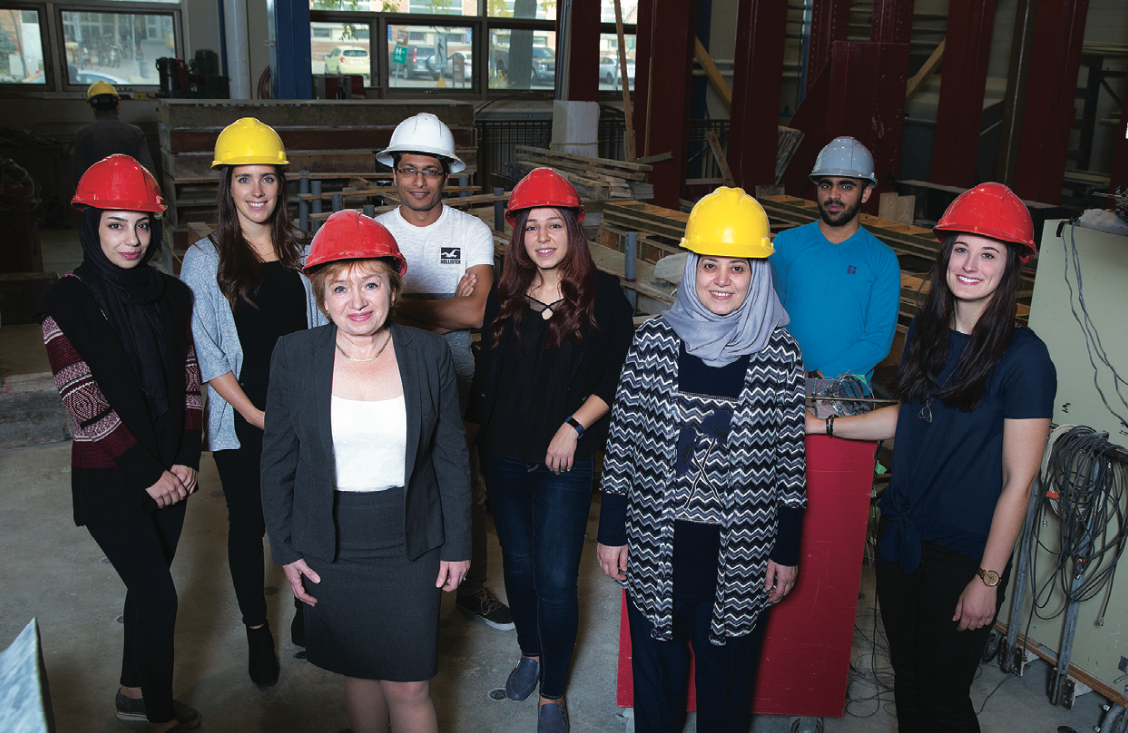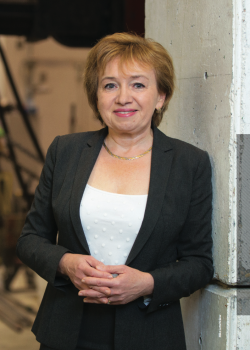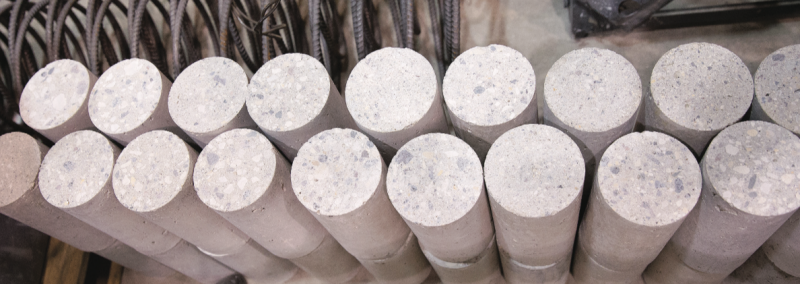
Dagmar Svecova with students Arezo Rasouli, Sarah Boila, Saeed Gerami, Dibasadat Yamoutzavareh, Maha Ghaib, Rushangkumar Dave and Heather Stefaniuk.
Creating unconventional solutions
Dagmar Svecova is helping keep Manitobans safe
A civil engineering professor and head of the department, Dagmar Svecova specializes in structural engineering research.
“I specialize in the area of reinforced and pre-stressed concrete, fibre-reinforced polymers (FRPs) and timber,” Svecova explains. “Most of my work is focused on infrastructure and testing new concepts and materials.”
One tested, retested and approved, these new concepts and materials are applied to and integrated into the construction and rehabilitation of roadways, culverts, bridges, balconies and buildings across the province and around the world. They make infrastructure steadier, sturdier, more robust and more reliable.
Born and raised in the former Czechoslovakia, Svecova came to Canada to pursue a MSc and PhD at Carleton University in Ottawa. In 1998, she moved west to join the U of M as a post-doctoral fellow, and in 2000 was hired as an assistant professor. A dozen years later Svecova was named director of SIMTReC, the Structural Innovation and Monitoring Technologies Resource Centre formerly known as the ISIS Canada Research Network. While she remains a program leader at SIMTReC, Svecova gave up the directorship in 2017 when she was appointed department head.
Svecova carries out the bulk of her research at the W.R. McQuade Structures Lab on the Fort Garry Campus, with sup- port from Research Manitoba, Manitoba Infrastructure, NSERC, SIMTReC and industry partners. Abetted by a nine-person research group, she designs samples and custom-designed loading frames, conducts testing, analyzes components and data, and imagines and invents new ways to construct, strengthen, renovate and repair essential infrastructure.
Two of Svecova’s current projects involve assessing the performance of high strength concrete as joint fill material for bridge decks, and developing a load testing facility to assess the strength of deteriorating and debilitated steel culverts.
“This will be a unique facility that will enable us to test culverts in conditions very similar to field conditions,” she explains. “Soil-structural interaction is very complex and we can learn a lot from being able to simulate the actual loading conditions in the lab and by monitoring the strains in the structure during load application.”
A third project, being conducted in collaboration with Red River College and local engineering consulting firm, Crosier Kilgour and Partners, is researching the development of a new kind of thermal break, or barrier, to help reduce the significant heat loss that occurs in high rise buildings with large concrete balconies.
“Commercial alternatives of thermal breaks are available but prohibitively expensive,” Svecova says.
It is her intention, she elaborates, to create a thermal break that will be both affordable and effective in lowering heat loss, especially during Manitoba’s harsh winters.
“I try to help solve actual problems that arise in the field using new materials, monitoring technologies, or innovative rehabilitation schemes,” Svecova says.
“Usually,” she continues, “the province or somebody comes to me and says we are having an issue with this, and we will look together on finding a solution, and how this problem can be alleviated. Most of the time, as one part of the solution, there will be a model set up in the laboratory for testing.”
In her determination to solve critical structural problems, and in so doing make those structures sounder and safer, Svecova has tested myriad materials and components, and savoured significant breakthroughs. Recently, she helped devise a method to rehabilitate several old bridges in the province that were originally designed and constructed out of lumber.
“We have more than 800 of these bridges in the province,” Svecova says, “and they were built many years ago. Right now the loads are increasing on the bridges and the bridges have been in service for many years, so they need to increase their capacity.”
After months of testing, Svecova and her team decided that the best way to increase that capacity, and strengthen the bridges, was to incorporate fiber-reinforced polymers into the infrastructure. To date, that method has been used to revive about a half dozen local bridges that would be far too expensive to replace.
“We always try to see how can we solve a problem unconventionally and for a reasonable cost,” says Svecova, “or use solutions that, in some cases, have not been applied or tried before, or that maybe need improving.”
In addition to actively seeking these solutions, lecturing students on structural analysis and reinforced concrete, and overseeing her department, Svecova sits on two national committees tasked with developing civil engineering codes for the use of FRPs in buildings and in bridges.
Engineering codes, after all, are essential to ensuring structural safety, and ensuring structural safety is essential to Dagmar Svecova.
Story originally published in ResearchLIFE Winter 2018 Edition. Read the full magazine online.
Research at the University of Manitoba is partially supported by funding from the Government of Canada Research Support Fund.








